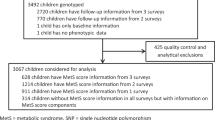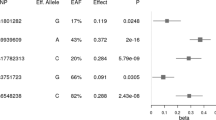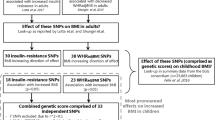Abstract
Background/objectives
The prevalence of abdominal obesity in Mexican children has risen dramatically in the past decade. Genome-wide association studies (GWAS) for waist-to-hip ratio (WHR) performed predominantly in European descent adult populations have identified multiple single-nucleotide polymorphisms (SNPs) with larger effects in women. The contribution of these SNPs to WHR in non-European children is unknown.
Subjects/methods
Mexican children and adolescents (N = 1421, 5–17 years) were recruited in Mexico City. Twelve GWAS SNPs were genotyped using TaqMan Open Array and analyzed individually and as a gene score (GS).
Results
Mexican boys and girls displayed 2.81 ± 0.29 and 3.10 ± 0.31 WHR standard deviations higher than children and adolescents from the United States. WHR was positively associated with TG (β = 0.733 ± 0.190, P = 1.1 × 10−4) and LDL-C (β = 0.491 ± 0.203, P = 1.6 × 10−2), and negatively associated with HDL-C (β = −0.652 ± 0.195, P = 8.0 × 10−4), independently of body mass index. The effect allele frequency (EAF) of 8 of 12 (67%) SNPs differed significantly (P < 4.17 × 10−3) in Mexican children and European adults, with no evidence of effect allele enrichment in both populations (4 depleted and 4 enriched; binomial test, P = 1). Ten out of 12 SNPs (83.3%) had effects that were directionally consistent with those reported in GWAS (P = 0.04). HOXC13 rs1443512 displayed the best fit when modeled recessively, and was significantly associated with WHR under a recessive mode of inheritance (β = 0.140 ± 0.06, P = 2.3 × 10−2). Significant interactions with sex were also observed for HOXC13 rs1443512 and the GS on WHR (P = 2.2 × 10−2 and 1.2 × 10−2, respectively). HOXC13 rs1443512 (β = 0.022 ± 0.012, P = 4.7 × 10−2) and the GS (β = 0.007 ± 0.003, P = 7.0 × 10−3) were significantly associated with WHR in girls only.
Conclusions
This study demonstrates that Mexican children are at high risk for abdominal obesity and detrimental lipid profiles. Our data support a partial transferability of sex-specific European GWAS WHR association signals in children and adolescents from the admixed Mexican population.
This is a preview of subscription content, access via your institution
Access options
Subscribe to this journal
Receive 12 print issues and online access
$259.00 per year
only $21.58 per issue
Buy this article
- Purchase on Springer Link
- Instant access to full article PDF
Prices may be subject to local taxes which are calculated during checkout
Similar content being viewed by others
References
Guh DP, Zhang W, Bansback N, Amarsi Z, Birmingham CL, Anis AH. The incidence of co-morbidities related to obesity and overweight: a systematic review and meta-analysis. BMC Public Health. 2009;9:88.
Stevens GA, Singh GM, Lu Y, Danaei G, Lin JK, Finucane MM, et al. National, regional, and global trends in adult overweight and obesity prevalences. Popul Health Metr. 2012;10:22–22.
Ng M, Fleming T, Robinson M, Thomson B, Graetz N, Margono C, et al. Global, regional, and national prevalence of overweight and obesity in children and adults during 1980–2013: a systematic analysis for the Global Burden of Disease Study 2013. Lancet. 2014;384:766–81.
Aceves-Martins M, Llauradó E, Tarro L, Solà R, Giralt M. Obesity-promoting factors in Mexican children and adolescents: challenges and opportunities. Glob Health Action. 2016;9:29625.
Stern D, Piernas C, Barquera S, Rivera JA, Popkin BM. Caloric beverages were major sources of energy among children and adults in Mexico, 1999-2012. J Nutr. 2014;144:949–56.
Okorodudu D, Jumean M, Montori VM, Romero-Corral A, Somers V, Erwin P, et al. Diagnostic performance of body mass index to identify obesity as defined by body adiposity: a systematic review and meta-analysis. Int J Obes. 2010;34:791–9.
National Obesity Observatory. Body mass index as a measure of obesity. http://www.thehealthwell.info/node/894434 (2009).
Schneider HJ, Friedrich N, Klotsche J, Pieper L, Nauck M, John U, et al. The predictive value of different measures of obesity for incident cardiovascular events and mortality. J Clin Endocrinol Metab. 2010;95:1777–85.
Huxley R, Mendis S, Zheleznyakov E, Reddy S, Chan J. Body mass index, waist circumference and waist: hip ratio as predictors of cardiovascular risk—a review of the literature. Eur J Clin Nutr. 2010;64:16–22.
Semiz S, Ozgören E, Sabir N. Comparison of ultrasonographic and anthropometric methods to assess body fat in childhood obesity. Int J Obes. 2007;31:53–58.
Wicklow BA, Becker A, Chateau D, Palmer K, Kozyrskij A, Sellers EA. Comparison of anthropometric measurements in children to predict metabolic syndrome in adolescence: Analysis of prospective cohort data. Int J Obes. 2015;39:1070–8.
Schleinitz D, Bottcher Y, Bluher M, Kovacs P. The genetics of fat distribution. Diabetologia. 2014;57:1276–86.
Randall JC, Winkler TW, Kutalik Z, Berndt SI, Jackson AU, Monda KL, et al. Sex-stratified genome-wide association studies including 270,000 individuals show sexual dimorphism in genetic loci for anthropometric traits. PLoS Genet. 2013;9:e1003500.
Wen W, Kato N, Hwang JY, Guo X, Tabara Y, Li H, et al. Genome-wide association studies in East Asians identify new loci for waist-hip ratio and waist circumference. Sci Rep. 2016;6:17958.
Liu CT, Monda KL, Taylor KC, Lange L, Demerath EW, Palmas W, et al. Genome-wide association of body fat distribution in African ancestry populations suggests new loci. PLoS Genet. 2013;9:e1003681.
Barquera S, Campos-Nonato I, Hernandez-Barrera L, Flores M, Durazo-Arvizu R, Kanter R, et al. Obesity and central adiposity in Mexican adults: results from the Mexican National Health and Nutrition Survey 2006. Salud Publica Mex. 2009;51(Suppl 4):S595–603.
Moreno-Estrada A, Gignoux CR, Fernandez-Lopez JC, Zakharia F, Sikora M, Contreras AV, et al. Human genetics. The genetics of Mexico recapitulates Native American substructure and affects biomedical traits. Science. 2014;344:1280–5.
Vogelezang S, Monnereau C, Gaillard R, Renders CM, Hofman A, Jaddoe VW, et al. Adult adiposity susceptibility loci, early growth and general and abdominal fatness in childhood: the Generation R Study. Int J Obes. 2015;39:1001–9.
Abadi A, Peralta-Romero J, Suarez F, Gomez-Zamudio J, Burguete-Garcia AI, Cruz M, et al. Assessing the effects of 35 European-derived BMI-associated SNPs in Mexican children. Obesity. 2016;24:1989–95.
Flegal KM, Cole TJ. Construction of LMS parameters for the Centers for Disease Control and Prevention 2000 growth charts. Natl Health Stat Report. 2013;63:1–4.
Sharma AK, Metzger DL, Daymont C, Hadjiyannakis S, Rodd CJ. LMS tables for waist-circumference and waist-height ratio Z-scores in children aged 5-19 y in NHANES III: association with cardio-metabolic risks. Pediatr Res. 2015;8:723–9.
Biro FM, Greenspan LC, Galvez MP, Pinney SM, Teitelbaum S, Windham GC, Deardorff J, Herrick RL, Succop PA, Hiatt RA, Kushi LH, Wolff MS. Onset of breast development in a longitudinal cohort. Pediatrics. 2013;134:1–9.
Herman-Giddens ME, Steffes J, Harris D, Slora E, Hussey M, Dowshen SA, Wasserman R, Serwint JR, Smitherman L, Reiter EO. Secondary sexual characteristics in boys: data from the pediatric research in office settings network. Pediatrics. 2012;130:1058–68.
Matthews DR, Hosker JP, Rudenski AS, Naylor BA, Treacher DF, Turner RC. Homeostasis model assessment: insulin resistance and beta-cell function from fasting plasma glucose and insulin concentrations in man. Diabetologia. 1985;28:412–9.
American Diabetes Association. Diagnosis and classification of diabetes mellitus. Diabetes Care. 2004;27(Suppl 1):S5–S10.
Langlois C, Abadi A, Peralta-Romero J, Alyass A, Suarez F, Gomez-Zamudio J, et al. Evaluating the transferability of 15 European-derived fasting plasma glucose SNPs in Mexican children and adolescents. Sci Rep. 2016;6:36202.
Heid IM. Meta-analysis identifies 13 new loci associated with waist-hip ratio and reveals sexual dimorphism in the genetic basis of fat distribution. Nat Genet. 2010;42:949–60.
Dudbridge F. Power and predictive accuracy of polygenic risk scores. PLoS Genet. 2013;9:e1003348.
Janssens AC, Moonesinghe R, Yang Q, Steyerberg EW, van Duijn CM, Khoury MJ. The impact of genotype frequencies on the clinical validity of genomic profiling for predicting common chronic diseases. Genet Med. 2007;9:528–35.
Robiou-du-Pont S, Bonnefond A, Yengo L, Vaillant E, Lobbens S, Durand E, et al. Contribution of 24 obesity-associated genetic variants to insulin resistance, pancreatic beta-cell function and type 2 diabetes risk in the French population. Int J Obes. 2013;37:980–5.
Burnham KP, Anderson DR. Model selection and multimodel inference: a practical information-theoretic approach. 2nd ed. New York, NY: Springer-Verlag New York Inc., 2002.
Feise RJ. Do multiple outcome measures require p-value adjustment? BMC Med Res Methodol. 2002;2:8.
Team RC. R: A language and environment for statistical computing. Vienna, Austria:R Foundation for Statistical Computing; 2014.
Graffelman J. Exploring diallelic genetic markers: the hardyweinberg package. J Stat Softw. 2015;64:1–23.
Aulchenko YS, Ripke S, Isaacs A, van Duijn CM. GenABEL: an R library for genome-wide association analysis. Bioinformatics. 2007;23:1294–6.
Gnatiuc L, Alegre-Diaz J, Halsey J, Herrington WG, Lopez-Cervantes M, Lewington S, et al. Adiposity and blood pressure in 110 000 Mexican adults. Hypertension. 2017;69:608–14.
Vazquez G, Duval S, Jacobs DR Jr., Silventoinen K. Comparison of body mass index, waist circumference, and waist/hip ratio in predicting incident diabetes: a meta-analysis. Epidemiol Rev. 2007;29:115–28.
Wells J. Sexual dimorphism of body composition. Best Pract Res Clin Endocrinol Metab. 2007;21:415–30.
Simón Barquera IC-N, Hernández-Barrera Lucía, Flores Mario, Durazo-Arvizu Ramón. Rebecca Kanter, Juan A Rivera. Obesity and central adiposity in Mexican adults: results from the Mexican National Health and Nutrition Survey 2006. Salud pública Méx. 2009;51:595–603.
Stryjecki C, Peralta-Romero J, Alyass A, Karam-Araujo R, Suarez F, Gomez-Zamudio J, et al. Association between PPAR-gamma2 Pro12Ala genotype and insulin resistance is modified by circulating lipids in Mexican children. Sci Rep. 2016;6:24472.
Bibiloni Mdel M, Salas R, Novelo HI, Villarreal JZ, Sureda A, Tur JA. Serum lipid levels and dyslipidaemia prevalence among 2-10 year-old Northern Mexican children. PLoS ONE. 2015;10:e0119877.
Klimentidis YC, Miller GF, Shriver MD. The relationship between European genetic admixture and body composition among Hispanics and Native Americans. Am J Human Biol. 2009;21:377–83.
WD HammerLD, Litt, Killen IF, Hayward JD, Miner C, Vosti B, Taylor C. CB. Impact of pubertal development on body fat distribution among white, Hispanic, and Asian female adolescents. J Pediatr. 1991;118:975–80.
Winkler TW, Justice AE, Graff M, Barata L, Feitosa MF, Chu S et al. The influence of age and sex on genetic associations with adult body size and shape: A large-scale genome-wide interaction study. PLoS Genet. 2015;11:e1005378.
Shungin D, Winkler TW, Croteau-Chonka DC, Ferreira T, Locke AE, Mägi R, et al. New genetic loci link adipose and insulin biology to body fat distribution. Nature. 2015;518:187–208.
Hill WG, Goddard ME, Visscher PM. Data and theory point to mainly additive genetic variance for complex traits. PLoS Genet. 2008;4:e1000008.
Wermter AK, Scherag A, Meyre D, Reichwald K, Durand E, Nguyen TT, et al. Preferential reciprocal transfer of paternal/maternal DLK1 alleles to obese children: first evidence of polar overdominance in humans. Eur J Hum Genet. 2008;16:1126–34.
Hoggart CJ, Venturini G, Mangino M, Gomez F, Ascari G, Zhao JH, et al. Novel approach identifies SNPs in SLC2A10 and KCNK9 with evidence for parent-of-origin effect on body mass index. PLoS Genet. 2014;10:e1004508.
Tukiainen T, Pirinen M, Sarin AP, Ladenvall C, Kettunen J, Lehtimaki T, et al. Chromosome X-wide association study identifies Loci for fasting insulin and height and evidence for incomplete dosage compensation. PLoS Genet. 2014;10:e1004127.
Okada Y, Kubo M, Ohmiya H, Takahashi A, Kumasaka N, Hosono N, et al. Common variants at CDKAL1 and KLF9 are associated with body mass index in east Asian populations. Nat Genet. 2012;44:302–6.
Buchner DA, Nadeau JH. Contrasting genetic architectures in different mouse reference populations used for studying complex traits. Genome Res. 2015;25:775–91.
Wei WH, Hemani G, Haley CS. Detecting epistasis in human complex traits. Nat Rev Genet. 2014;15:722–33.
van Vliet-Ostaptchouk JV, den Hoed M, Luan J, Zhao JH, Ong KK, van der Most PJ, et al. Pleiotropic effects of obesity-susceptibility loci on metabolic traits: a meta-analysis of up to 37,874 individuals. Diabetologia. 2013;56:2134–46.
Kasus-Jacobi A, Perdereau D, Auzan C, Clauser E, Van Obberghen E, Mauvais-Jarvis F, et al. Identification of the rat adapter Grb14 as an inhibitor of insulin actions. J Biol Chem. 1998;273:26026–35.
Perichart-Perera O, Balas-Nakash M, Schiffman-Selechnik E, Barbato-Dosal A, Vadillo-Ortega F. Obesity increases metabolic syndrome risk factors in school-aged children from an urban school in Mexico city. J Am Diet Assoc. 2007;107:81–91.
Stryjecki C, Alyass A, Meyre D Ethnic and population differences in the genetic predisposition to human obesity. Obes Rev. 2017;19:62–80.
Graff M, North KE, Richardson AS, Young KL, Mazul AL, Highland HM, Mohlke KL, Lange LA, Lange EM, Mullan Harris K, Gordon-Larsen P. BMI loci and longitudinal BMI from adolescence to young adulthood in an ethnically diverse cohort. Int J Obes. 2017; 41: 759–68.
Pigeyre M, Yazdi FT, Kaur Y, Meyre D. Recent progress in genetics, epigenetics and metagenomics unveils the pathophysiology of human obesity. Clin Sci (Lond, Engl: 1979). 2016;130:943–86.
Acknowledgements
We thank all the study participants and the reviewers for their helpful comments. We thank Carolina Stryjecki for her technical assistance. D.M. is supported by a Tier 2 Canada Research Chair in Genetics of Obesity. This work was supported by Fundación IMSS A.C. and by the National Council of Science and Technology (CONACYT-México) with the grant SALUD-2013-C01-201471 (FONSEC SSA/IMSS/ISSSTE).
Author information
Authors and Affiliations
Corresponding authors
Ethics declarations
Conflict of interest
The authors declare that they have no conflict of interest.
Rights and permissions
About this article
Cite this article
Turcotte, M., Abadi, A., Peralta-Romero, J. et al. Genetic contribution to waist-to-hip ratio in Mexican children and adolescents based on 12 loci validated in European adults. Int J Obes 43, 13–22 (2019). https://doi.org/10.1038/s41366-018-0055-8
Received:
Revised:
Accepted:
Published:
Issue Date:
DOI: https://doi.org/10.1038/s41366-018-0055-8
This article is cited by
-
Predictors of central and general obesity in Iranian preschool children: which anthropometric indices can be used as screening tools?
BMC Pediatrics (2022)
-
HOXC13 promotes cervical cancer proliferation, invasion and Warburg effect through β-catenin/c-Myc signaling pathway
Journal of Bioenergetics and Biomembranes (2021)
-
Relationships between menstrual status and obesity phenotypes in women: a cross-sectional study in northern China
BMC Endocrine Disorders (2020)



